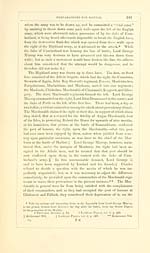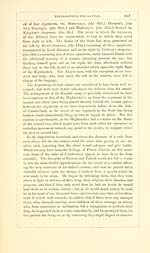Download files
Complete book:
Individual page:
Thumbnail gallery: Grid view | List view

242
HISTORY OF THE HIOHT.ANDS.
present oncasion, as ominous.* The duke of Peith, while he stood at
the head of the Glengary regiment, hearing the murmurs of the Mac-
donalds, said, tliat if tliiy behaved with their usual valour, they would
make a right of the left, and that he would change his name to Mac-
donald ; but these proud clansmen lent a deaf ear to him.
The second line of the Highland army consisted of the Gordons un-
der Lord Lewis Gordon, formed in column on the right, the French
Royal Scots, the Irish piquets or brigade, Lord Kilmarnock's foot guards,t
Lord John Drumniond's regiment, and Glenbucket's regiment in column
on the left, Hanked on the right by Fitz-Jaraes's dragoons, and Lord
Elcho's horse-guards, and on the left by the Perth squadron, under Lords
Strathallan and Pitsligo, and the prince's body-guards under Lord Bal-
merino. General Stapleton had the command of this line. The third
line, or reserve, consisted of the duke of Perth's and Lord Ogilvy's regi-
ments, under the last-mentioned nobleman. The prince himself, sur-
rounded by a troop of Fitz-James's horse, took his station on a very
small eminence behind the centre of the first line, from which he had
a complete view of the whole field of battle. The extremities of the
front line and the centre were each protected by four pieces of caunon.J
The English army continued steadily to advance in the order already
described, and, alter a march of eight miles, formed in order of battle,
in consequence of the advanced guard reporting that they perceived the
Highland army at some distance making a motion towards them on the
left. Finding, however, that the Highlanders were still at a considerable
distance, and that the whole body did not move forward, the duke of
Cumberland resumed his march as before, and continued to advance till
within a mile of the position occupied by the Highland army, when he
ordered a halt, and, after reconnoitring the position of the Highlanders,
again formed his army for battle in three lines, and in the following
order.
The first line consisted of six regiments, viz. the Royals, (the 1st,)
Cholmondley's, (the 34th,) Price's, (the 14th,) the Scots Fusileers, (the
21st,) Monro's, (the 37th,) and Barrel's, (the 4th). The earl of Albe-
marle had the command of this line. In the intermediate spaces be-
tween each of these regiments were placed two pieces of cannon, mak-
ing ten in whole. The second line, which consisted of five regiments,
comprised those of Pulteney, (the 13th,) Bligh, (the 20th,) Sempil, (the
25th,) Ligonier, (the 48tli,) and Wolfe's, (the 8th,) and was under the
command of General Huske. Three pieces of cannon were placed be-
tween the exterior regiments of this line and those next them. The
third line or corps de reserve, under Brigadier Mordaunt, consist-
• Loikliart Papers, vol. ii. p 510.
+ These guards were originally a body of cavalry, called the horse-grenadiers, but thej
were dismounted, and their horses were given to the men of Fitz-James's regiment, who
hail landed in Scuiland «iihoul horses.
t l<iil,iv,nnel MS. Home's Works, vol. iii. p. 211.
HISTORY OF THE HIOHT.ANDS.
present oncasion, as ominous.* The duke of Peith, while he stood at
the head of the Glengary regiment, hearing the murmurs of the Mac-
donalds, said, tliat if tliiy behaved with their usual valour, they would
make a right of the left, and that he would change his name to Mac-
donald ; but these proud clansmen lent a deaf ear to him.
The second line of the Highland army consisted of the Gordons un-
der Lord Lewis Gordon, formed in column on the right, the French
Royal Scots, the Irish piquets or brigade, Lord Kilmarnock's foot guards,t
Lord John Drumniond's regiment, and Glenbucket's regiment in column
on the left, Hanked on the right by Fitz-Jaraes's dragoons, and Lord
Elcho's horse-guards, and on the left by the Perth squadron, under Lords
Strathallan and Pitsligo, and the prince's body-guards under Lord Bal-
merino. General Stapleton had the command of this line. The third
line, or reserve, consisted of the duke of Perth's and Lord Ogilvy's regi-
ments, under the last-mentioned nobleman. The prince himself, sur-
rounded by a troop of Fitz-James's horse, took his station on a very
small eminence behind the centre of the first line, from which he had
a complete view of the whole field of battle. The extremities of the
front line and the centre were each protected by four pieces of caunon.J
The English army continued steadily to advance in the order already
described, and, alter a march of eight miles, formed in order of battle,
in consequence of the advanced guard reporting that they perceived the
Highland army at some distance making a motion towards them on the
left. Finding, however, that the Highlanders were still at a considerable
distance, and that the whole body did not move forward, the duke of
Cumberland resumed his march as before, and continued to advance till
within a mile of the position occupied by the Highland army, when he
ordered a halt, and, after reconnoitring the position of the Highlanders,
again formed his army for battle in three lines, and in the following
order.
The first line consisted of six regiments, viz. the Royals, (the 1st,)
Cholmondley's, (the 34th,) Price's, (the 14th,) the Scots Fusileers, (the
21st,) Monro's, (the 37th,) and Barrel's, (the 4th). The earl of Albe-
marle had the command of this line. In the intermediate spaces be-
tween each of these regiments were placed two pieces of cannon, mak-
ing ten in whole. The second line, which consisted of five regiments,
comprised those of Pulteney, (the 13th,) Bligh, (the 20th,) Sempil, (the
25th,) Ligonier, (the 48tli,) and Wolfe's, (the 8th,) and was under the
command of General Huske. Three pieces of cannon were placed be-
tween the exterior regiments of this line and those next them. The
third line or corps de reserve, under Brigadier Mordaunt, consist-
• Loikliart Papers, vol. ii. p 510.
+ These guards were originally a body of cavalry, called the horse-grenadiers, but thej
were dismounted, and their horses were given to the men of Fitz-James's regiment, who
hail landed in Scuiland «iihoul horses.
t l<iil,iv,nnel MS. Home's Works, vol. iii. p. 211.
Set display mode to: Large image | Transcription
Images and transcriptions on this page, including medium image downloads, may be used under the Creative Commons Attribution 4.0 International Licence unless otherwise stated. ![]()
| Early Gaelic Book Collections > Ossian Collection > History of the Highlands and of the Highland clans > Volume 3 > (276) |
|---|
| Permanent URL | https://digital.nls.uk/79655734 |
|---|
| Description | Vol. III. |
|---|---|
| Shelfmark | Oss.249 |
| Attribution and copyright: |
|
| Description | Selected books from the Ossian Collection of 327 volumes, originally assembled by J. Norman Methven of Perth. Different editions and translations of James MacPherson's epic poem 'Ossian', some with a map of the 'Kingdom of Connor'. Also secondary material relating to Ossianic poetry and the Ossian controversy. |
|---|
| Description | Selected items from five 'Special and Named Printed Collections'. Includes books in Gaelic and other Celtic languages, works about the Gaels, their languages, literature, culture and history. |
|---|

